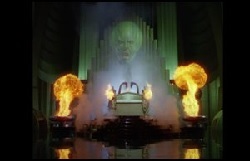By Pam Martens and Russ Martens: February 12, 2018
Here’s what is feeding fear in the stock market:
Trump’s presidency is spinning out of control leaving no adults in the room; the much ballyhooed tax cut legislation is actually going to produce frightening budget deficits that push up interest rates to a level that crashes the stock market; the Republican Party that pushed for this fiscally-irresponsible tax cut plan will be responsible for handing the House over to Democrats in the midterms, putting an end to the deregulation perks to corporations that have buoyed this stock market; if the House shifts leadership so will important House Committees like Intelligence and Financial Services, which may decide to start issuing meaningful subpoenas.
And that’s just for starters. A big fear that is much less talked about involves the changing role that global central banks have played in stock and bond markets.
The U.S. central bank, the Federal Reserve, is tapering the amount of U.S. Treasuries it buys as part of its efforts to unwind its massive balance sheet that was amassed as part of its Quantitative Easing (QE) programs that followed the financial crash of 2008.
The Federal Reserve began its tapering in October of last year with the Fed shrinking the amount of maturing Treasury principal it was rolling over into new Treasuries by $6 billion a month. That figure has now grown to $12 billion a month. The shrinkage amount will grow gradually until October of this year when the Fed will roll over $30 billion less each month in Treasuries going forward than it had in prior years. That’s a whopping $360 billion of missing demand at a time of mushrooming supply that results from the growing deficits created by the ill-advised corporate tax cuts.
As Nomi Prins brilliantly details in her new book coming out in May, Collusion: How Central Bankers Rigged the World, the U.S. is headed toward another epic financial crash as a result of the unchecked powers of the U.S. central bank and its global counterparts who have created dangerous new asset bubbles. Prins makes a very convincing case that colluding central bankers have effectively become the markets through a never-ending flow of cheap money to the mega banks.
Then there is the mind-boggling reality that some central banks are actually boosting stock markets by outright buying of stocks. As we reported on August 25 of last year:
“Since June 30 of last year, Switzerland’s central bank, the Swiss National Bank, has increased its stock holdings of five U.S. social media/tech stocks from $5.3 billion to $9.38 billion, an increase of 77 percent in 12 months. The stocks are Apple, Alphabet (parent to Google), Microsoft, Amazon and Facebook. The stock information comes from a 13F filing the Swiss National Bank made this month with the U.S. Securities and Exchange Commission (SEC), a quarterly form required of institutional investment managers who manage $100 million or more.
“According to the SEC form, the Swiss central bank owns the following positions as of June 30, 2017: $2.76 billion in Apple common stock; over $2 billion in two classes of Alphabet stock; $1.864 billion in Microsoft common; $1.434 billion in Amazon common; and $1.32 billion in Facebook Class A. It owns tens of billions of dollars more in other U.S. and global stocks.”
In November, Quartz reported that the Swiss National Bank had amassed an $88 billion stock portfolio of U.S. equities and detailed its actions as follows:
“The SNB has $836 billion of assets on its balance sheet. This isn’t huge as far as central banks go. The Federal Reserve, the European Central Bank (ECB), and the Bank of Japan (BOJ) all have five to six times that amount on theirs; the Fed alone has assets of $4.5 trillion. But the SNB’s balance sheet is striking compared to the size of the Swiss economy. The totality of the assets held by the Fed, the ECB, and the BOJ’s work out to 23%, 40%, and 90% of their countries’ annual GDP, respectively; the SNB’s assets are a full 127% of the Swiss GDP.
“That means that the SNB has invested a quarter more than its entire economy produces in a year.”
The Swiss central bank is one of about a dozen central banks that have bought stocks since the financial crisis. Japan and Israel’s central banks are two of the dozen. In April 2016, Economist Ed Yardeni called it a Ponzi scheme, writing on his web site:
“In the long run, it’s hard to imagine that having the central monetary planners buy corporate bonds and stocks with the money they print can end well. In effect, the central banks are turning into the world’s biggest hedge funds, financed by their own internal primary (money-printing) dealers and backstopped by the government — which can always borrow more from the central bank or force taxpayers to make good on this Ponzi scheme…”


